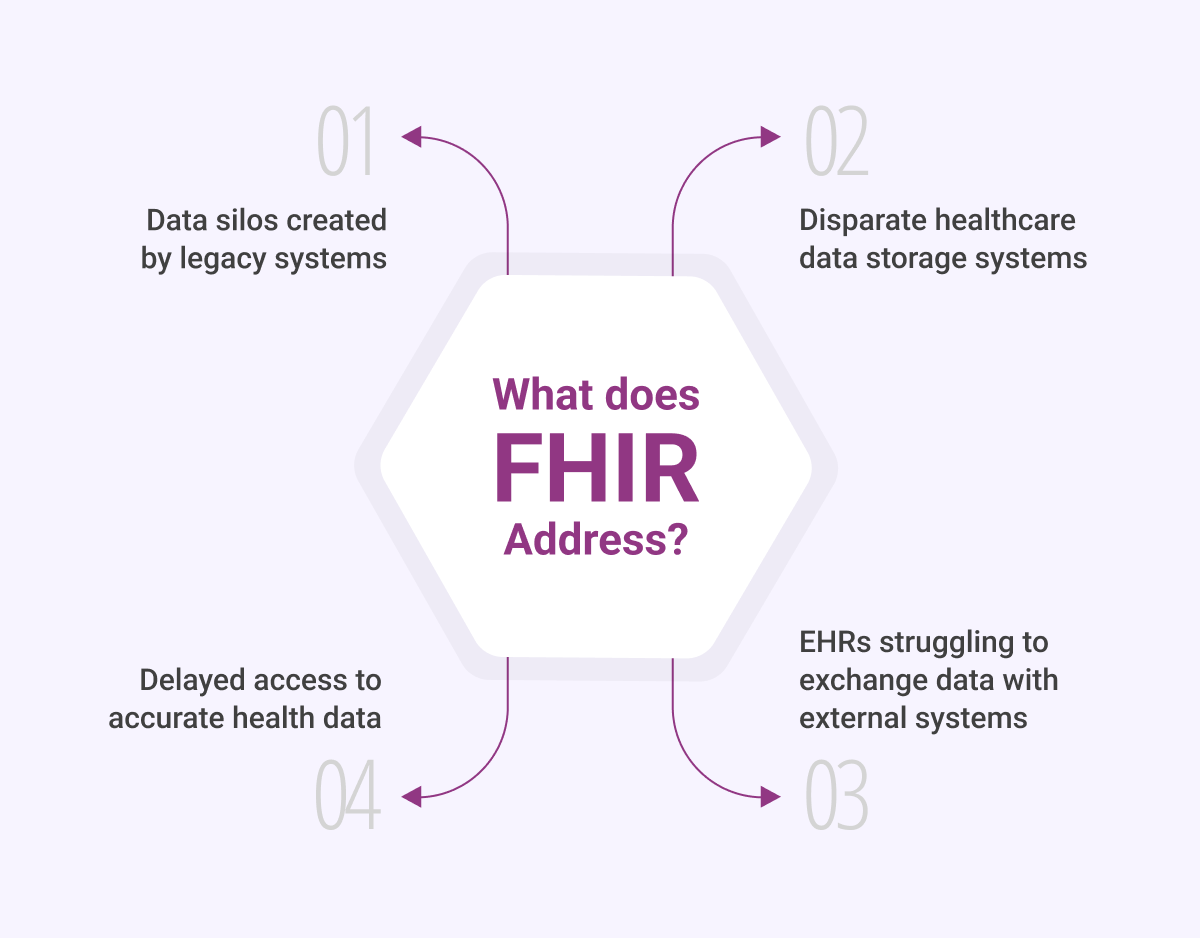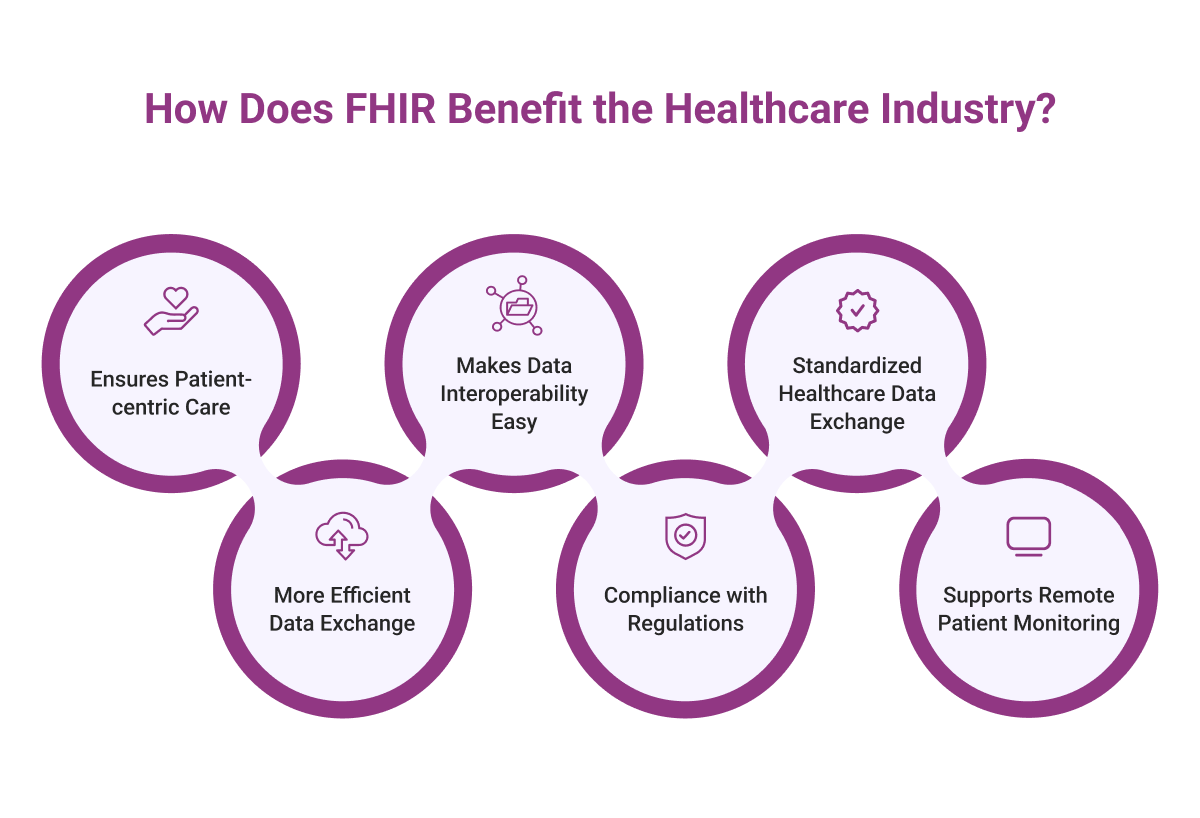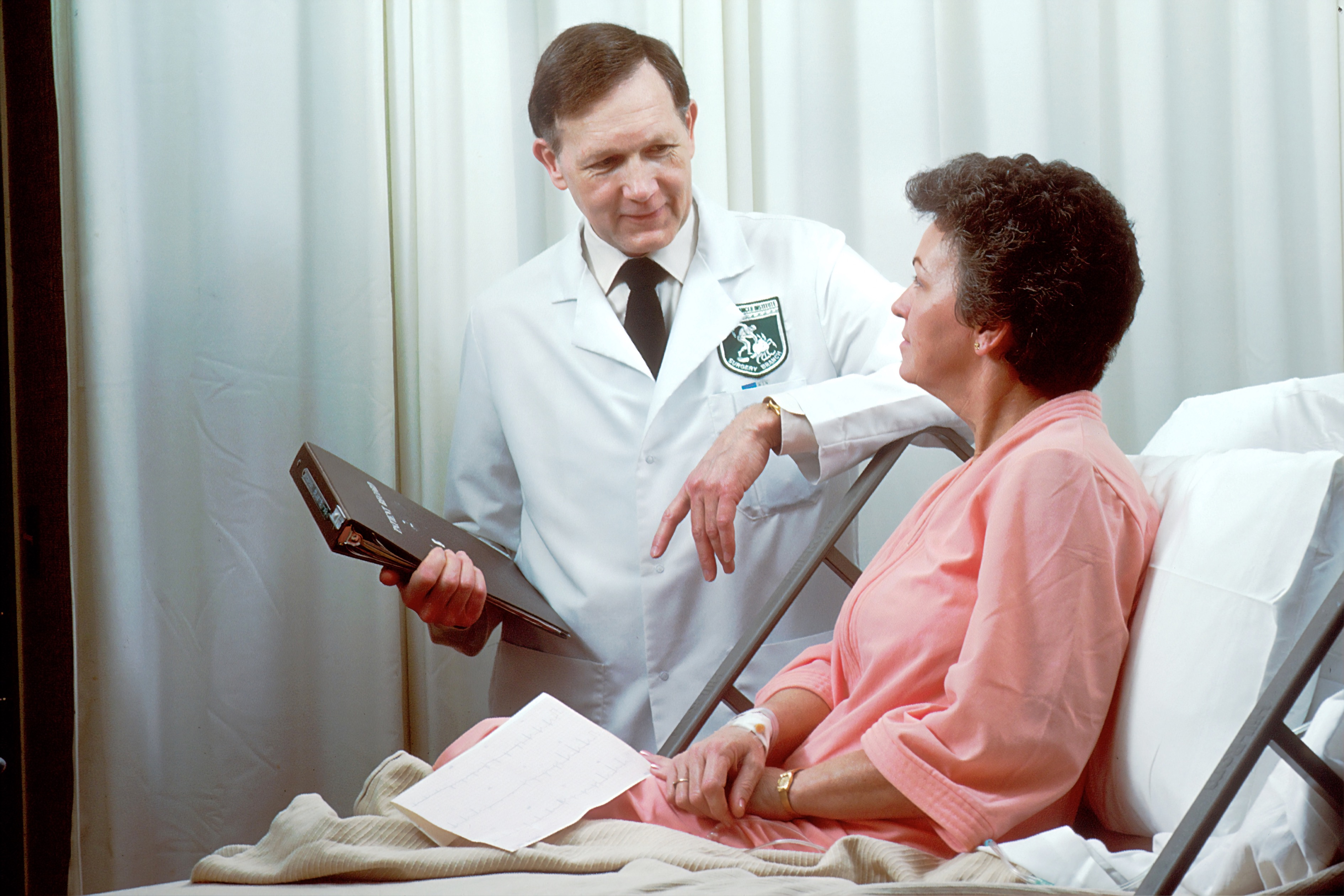Origin and Evolution of the Concept of FHIR
As with every industry, healthcare primarily provides high-quality care to patients at the right time. This requires timely access to and exchange of accurate health data. An ever-growing amount of healthcare data, the rise of “online culture”, and heavy reliance on digital technology have made adopting modern technologies necessary in healthcare. Enter the need for a standardized, secure, quick, and easy data exchange between various healthcare information systems, databases, applications, and software used across the healthcare industry.
Regulatory initiatives in the United States have played a crucial role in advancing healthcare interoperability. The journey commenced in 2019 with the initiation of Federal Interoperability Efforts dedicated to fostering and executing interoperability. A pivotal government initiative, the draft of the Trusted Exchange Framework and Common Agreement (TEFCA) surfaced in 2018. Subsequently, 2019 marked the initiation of collaborative efforts with various regulations, witnessing annual advancements in interoperability.
A breakthrough occurred in 2021 when every ONC-certified Electronic Health Record (EHR) system in the US was mandated to implement Fast Healthcare Interoperability Resources (FHIR). This requirement represented a significant stride in interoperability, laying the foundation for the current state of affairs.
What is FHIR?
According to the HL7 website, “The philosophy behind FHIR is to build a base set of resources that, either by themselves or when combined, satisfy the majority of common use cases. FHIR resources aim to define the information contents and structure for the core information set shared by most implementations.”
Interoperability and standardization lie at the heart of FHIR (Fast Healthcare Interoperability Resources). Created by the HL7, a non-profit standards development organization that focuses on the interoperability of health information technology, FHIR is a standard that defines how healthcare information is stored and exchanged electronically. FHIR data models use modern web technologies to facilitate easy and timely access to core clinical and administrative data.
Why Does the Healthcare Industry Need Interoperability?

So why is FHIR such a big deal for the healthcare industry? This is because, sadly, outdated systems such as email or fax machines and document-based records still act as barriers to seamless health data exchange and access. These legacy systems create data silos, making it difficult for healthcare providers to access patient data with full context, such as patient history and previous records.
The diverse and disconnected data sets or systems that store healthcare information lack standardization. Disparate data sources often use different formats, standards, or data models, making it challenging for systems to understand and interpret information consistently. This lack of interoperability hinders seamless data exchange between different healthcare applications and systems.
Healthcare IT systems such as EHRs are used extensively in different healthcare organizations. However, these systems face challenges when it comes to seamlessly exchanging data with external systems such as laboratories, imaging systems, pharmacies, and other healthcare providers.
Timely access to accurate patient data is crucial in healthcare, especially in situations of emergency or urgent care. FHIR supports real-time data exchange, which allows healthcare providers to access the most recent information when it is needed the most.
How Does FHIR Facilitate Interoperability?
Interoperability is about prioritizing and sharing the patient’s complete story. FHIR makes the shift to patient-centric healthcare possible by ensuring that patients and healthcare providers get accurate information from health IT systems. Through FHIR, different computer systems can easily exchange updated clinical and administrative data for the well-being of a patient receiving medical care.
The quest for organizing and securely storing healthcare data initiated the development of FHIR around 2011, and it was officially released as a draft standard in 2014. FHIR defines a set of standardized data elements known as resources or data models.
Each resource has a tag that acts as a unique identifier, just like the URL of a web page. These resources represent different types of core healthcare data, such as information about patients, providers, observations, medications, care plans, and more. About 150 of these are listed in the FHIR guidelines. The use of these standardized resources allows for consistent representation and interpretation of data across diverse healthcare systems.
With FHIR, the goal was to create a standard that leverages modern web technologies like RESTful APIs (Representational State Transfer Application Programming Interfaces). RESTful APIs make it easier for different systems to communicate and share healthcare data over standard HTTP protocols. Since these web standards are widely used and familiar outside of the healthcare industry, software developers can easily implement these standards without prior experience in healthcare IT.
Types of Services and Solutions Provided Around FHIR Implementation by Vendors
Electronic Health Record systems, patient portals, mobile health applications, and telemedicine platforms can all be built using FHIR guidelines.
- FHIR Consulting Services: Vendors can help healthcare organizations by evaluating the organization’s readiness for FHIR implementation, formulating a strategic plan for FHIR adoption aligned with organizational goals, and creating a roadmap for implementing FHIR standards.
- FHIR Integration Services: Vendors can assist healthcare organizations looking to integrate FHIR with existing healthcare systems, such as EHRs, laboratory information systems, etc. This can be done by building interfaces and connectors to enable seamless data exchange between diverse healthcare applications and designing and implementing FHIR-based APIs.
- FHIR Application Development: Vendors can develop bespoke applications that leverage FHIR standards to enhance specific healthcare workflows such as patient engagement, clinical decision-making, and more. Mobile Health (mHealth) Apps that utilize FHIR for secure health data exchange can also be developed.
- FHIR-enabled EHR Solutions: Apart from integrating FHIR capabilities into existing EHR systems to enhance interoperability and data exchange, vendors can develop modular components that extend EHR functionalities using FHIR standards.
- FHIR Data Analytics: Vendors can also help healthcare organizations make sense of the wealth of information available in FHIR-enabled data by developing custom dashboards and visualizations, identifying patterns and trends, and creating predictive models.
- Security and Compliance: Vendors can further implement security measures to protect FHIR data during transmission and storage and ensure that FHIR implementations adhere to relevant healthcare data exchange standards and regulations such as the Health Insurance Portability and Accountability Act or HIPAA.
- FHIR Testing Services: This involves vendors conducting testing procedures to ensure seamless interoperability between different FHIR-enabled systems and verifying that FHIR implementations comply with FHIR standards and specifications.
Benefits of Implementing FHIR for the Healthcare Industry
As technology continues to grow and advance, FHIR facilitates a better digital healthcare ecosystem by harnessing the true potential of digitization. From patients to care providers, researchers, and decision-makers, FHIR benefits everyone within the healthcare industry.

1. Ensuring Patient-centric Care
Patients can interact with different healthcare providers with a single personal health record that provides a holistic view of the patient’s updated medical history. This enables healthcare providers to make well-informed, timely decisions, reducing the possibility of errors in personalized treatment plans.
FHIR also enables patients to have greater control over their own health data through standardized access and authorization mechanisms, which allows patients to share their data with providers and caregivers as needed.
2. Data Interoperability Made Easy
By providing a standardized framework for the exchange of healthcare information, FHIR facilitates quick and consistent communication between different platforms in an industry with diverse and often proprietary systems working together. When these systems are made interoperable, healthcare providers and other professionals can access a patient’s healthcare data from various sources, such as electronic health records (EHRs), health information exchanges (HIEs), and other health applications.
3. Standardization in Healthcare Data Exchange
FHIR ensures a standardized way of representing and exchanging healthcare data by defining a set of standardized resources or data elements that can be used to represent healthcare information. The use of standardized resources allows for consistent representation and interpretation of data across diverse healthcare systems. This standardization is crucial for avoiding data silos, reducing errors, and ensuring that information is accurately and consistently interpreted across different platforms and applications.
4. More Efficient Data Exchange
The FHIR API is based on established web standards. It supports multiple data exchange formats, including XML, JSON, HTTP, OAuth, and REST, making it more adaptable to current technology trends. Using these well-known technologies makes it easier and faster to implement, even for developers without prior healthcare IT experience. This adaptability ensures that healthcare systems can evolve and integrate new technologies, fostering innovation and sustainability in the industry.
5. Compliance with Regulations
FHIR provides a foundation for healthcare organizations to build secure and privacy-conscious systems, aligning with regulations such as the Health Insurance Portability and Accountability Act (HIPAA) in the United States or the General Data Protection Regulation (GDPR) in the European Union. Apart from ensuring interoperability between healthcare systems, FHIR incorporates and supports standardized access controls, mechanisms for managing patient consent, audit trail creation, secure patient identity verification, and secure data transmission protocols.
6. Remote Patient Monitoring and Telehealth
FHIR supports remote patient monitoring and telehealth initiatives by enabling the seamless exchange of data from connected devices and telehealth platforms. This is especially significant in the context of modern healthcare delivery models.
Where Rockit Fills the Interoperability Gaps
Rockit stands as a leading force in healthcare interoperability, offering world-class HL7 and FHIR software development services to bridge critical gaps in the healthcare sector. We empower patients with member/patient portals, providing access to crucial health information. Our suite of FHIR software development services ensures:
- Comprehensive coverage, from expert FHIR engineering for seamless data exchange to innovative FHIR design that goes beyond standards, elevating healthcare software to new heights. Whether you’re a healthcare provider, executive, or leader, Rockit invites you to redefine healthcare with real-time, dependable, and scalable FHIR solutions.
- From FHIR-compliant EHR solutions for seamless health record synchronization to FHIR-based analytics boosting operational efficiency by 25%, Rockit accelerates project timelines by 30% with reusable components.
- Choosing Rockit means choosing technical proficiency in FHIR STU3 and R4, domain expertise that understands healthcare workflows, and a high success rate backed by a proven track record of delivering reliable results.
- For users, we promise accurate real-time visibility of data, better data management, and a good user experience. For executives and leaders, we promise dependable products, scalability, and a good return on investment.
Our approach blends domain expertise with innovative development methodologies, providing scalable and quality solutions. Connect with our experts today to embark on a journey to revolutionize healthcare through cutting-edge FHIR software development.
What’s Next for FHIR?
The evolution of FHIR is taking place in a period characterized by an unprecedented surge in the demand for and use of data. For patients and healthcare providers, FHIR aims to make healthcare similar to any other internet-based experience we can think of.
Patient-generated health data (PGHD) such as the data generated by wearable devices, mobile health (mHealth) applications, home monitoring devices, or healthcare Internet of Things, to name a few, contribute to a substantial amount of health data. But very little of this finds clinical usefulness. FHIR intends to bridge this gap by enabling patient-generated healthcare data to find clinical utility through FHIR-enabled applications.
With the FHIR R5 version update released earlier this year, it is set to transform how data is structured, accessed, and utilized for global public health.

